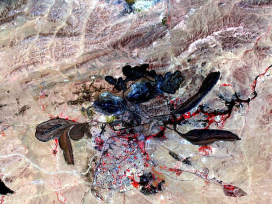“Of course companies that sell climate change solutions stand to benefit as greenhouse gas emissions come to bear a price tag.”
Daniel Esty Hillhouse, Professor of Environmental Law, Harvard University
The corporate raiders of the 1980s first worked out that you might be able to make more money downsizing, or even breaking up industry than building it up. It is a perverse result of the profit motive that private gain should grow out of public decay. But even the corporate raiders never dreamt of making deindustrialisation into an avowed policy goal which the rest of us would pay for.
What some of the cannier Green Capitalists realised is that scarcity increases price, and manufacturing scarcity can increase returns. What could be more old hat, they said, than trying to make money by making things cheaper? Entrepreneurs disdained the “fast moving consumer goods” market.
Of course there is a point to all this. If labour gets too efficient the chances of wringing more profits from industry get less. The more productive labour is, the lower, in the end, will be the rate of return on investments. That is because the source of new value is living labour; but greater investment in new technologies tends to replace living labour with machines, which produce no additional value of their own. Over time the rate of return must fall. Business theory calls this the diminishing rate of return. Businessmen know it as the “race for the bottom” – the competitive pressure to make goods cheaper and cheaper, making it that much harder to sell enough to make a profit. Super efficient labour would make the capitalistic organisation of industry redundant. Manufacturing scarcity, restricting output and so driving up prices is one short-term way to secure profits and maybe even the profit-system. Of course that would also mean abandoning the historic justification for capitalism, that it increased output and living standards. Environmentalism might turn out to be the way to save capitalism, just at the point when industrial development had shown it to be redundant.
From megawatts to negawatts
One of the most destructive examples of manufactured scarcity is “clean energy” and California’s “Negawatt Revolution”.
In 1997 the Club of Rome collaborated with Amory Lovins of the Rocky Mountain Institute to launch a new report “Factor Four” that promised to “halve resource use” while doubling wealth. The message was that you could get rich saving the planet. A privileged few did indeed double their wealth; but for the rest it was just a case of halving resources.
Immodestly, Lovins made his own California energy scheme the main example of savings in “Factor Four”. His well-paid advice to the State of California was that it was a big mistake to adopt a system that rewarded increased electricity output with increased profits. Such a system would naturally tend to boost output. Instead, rewards for cutting energy use were needed. Rather than getting paid for additional megawatts the utility companies should be rewarded for saving power use: negawatts.
The impact of Lovins’ model on energy generation in California was decisive. “Around 1980, Pacific Gas and Electricity Company was planning to build some 10-20 power stations”, according to Lovins.
But by 1992, PG&E was planning to build no more power stations, and in 1993, it permanently dissolved its engineering and construction division. Instead as its 1992 Annual Report pronounced, it planned to get at least three quarters of its new power needs in the 1990s from more efficient use by its customers.
Of course the PG&E was not getting three quarters of its new power needs from anywhere: it had just reduced its output. But manufacturing energy scarcity did indeed grow somebody’s cash wealth: Enron’s. With these artificial caps on energy production the generating companies could start to hike up the charges to utility companies, including PG&E, now unable to meet its own customers’ demands. Those energy companies were owned by Enron.
Chief Executive Kenneth Lay turned Enron from a company that made its money generating power into one that made its money trading finance. Whatever else it was doing, there was no denying that Enron was cutting back its own CO2 emissions and getting rich doing it. One company memo stated that the Kyoto treaty “would do more to promote Enron’s business than will almost any other regulatory initiative”.
Amory Lovins’ negawatt revolution in California was Enron’s wet dream. Having shut down its own generation capacity, PG&E was at the mercy of Enron’s market manipulation. Buying surplus electricity on the open market PG&E was royally fleeced, losing US$12 billion. Utility bills rose by nine times between May 2000 and May 2001. Enron took advantage of the restricted market and cut electricity to California. They even invented reasons to take power plants offline while California was blacked out. Enron officials joked that they were stealing one million dollars a day from California. The PG&E that Lovins held up as a model went bankrupt and had to be bailed out by the State of California.
The negawatt revolution in California was supposed to reward savings and alternative energy generation. In the event manufacturing scarcity only rewarded Enron’s crooked speculators, while penalising consumers.
Sadly, the lessons of the “negawatt revolution” have been buried in the outrage about Enron’s fraudulent market manipulation. Few people noticed that Enron’s executives were taking advantage of an artificial scarcity in energy supply engineered by Amory Lovins and the PG&E working in close association with Enron’s favourite green lobby, the National Resources Defence Council.
Few of Enron’s critics noticed that it was the very model of an environmentally friendly, post-industrial company and one that had taken Amory Lovins’ goal of doubling wealth by halving resource use to heart. Saving energy is of course good sense as long as that is done by resource efficiency. The Club of Rome’s claim that manipulating market prices to create incentives for reducing energy output which, in turn, can create efficiency is confused. All that achieved was an artificial shortage the condition for ramping up utility bills. The old-fashioned market incentive for energy efficiency is the savings people make on their bills when they insulate their homes, or turn down the air conditioning. Businesses, too, have every interest in keeping overheads low by using the energy they pay for wisely. Normal prices would give customers the incentive to reduce their electricity consumption.
But amazingly the Enron-Lovins model of restricting supply is the one that is being adopted around the world. Utility companies are rewarding consumers for reducing their consumption from central power stations and encouraging domestic-sited energy generation, through windmills and solar panels. Playing on Californians’ distrust of the power companies, the Environmental Protection Agency is planning to add solar power to one million new homes – paid for by another surcharge on utility bills. In Britain, the government is introducing regulations to make all new homes carbon-neutral. The current goal of carbon-neutral homes reverses the division of labour that saw specialised energy producers distribute electricity, turning it into an eighteenth century cottage industry. The simple economic lesson that mass production avoids reproduction of effort has been lost. Nothing could be more wasteful, or more certain to create new scarcity.
California’s “negawatt revolution” is only one of the more extreme versions of the way that green priorities work in tandem with profiting by manufacturing scarcity. South African radical Dominic Tweedie argues that recent electricity blackouts there happened because of “a campaign to impose artificial scarcity”. The failure to build power stations to meet the growing demand from South Africa’s black townships was not recognised as a problem by activists there because they bought into the green prejudice that social aspirations could be met by redistribution alone, at the expense of increased output. Now supply companies are hiking up prices to the people who can least afford them.
From negawatts to nega-nosh
Elsewhere, food supplies are failing because the European Union and the United Nations have pursued a 20-year policy of retiring land from production to arrest the fall in farm prices.
Engineering the retirement of farmland is largely a way of easing small farmers (who had been protected under the old Common Agricultural Policy) out of farming altogether. It has not hurt the larger agribusinesses, which are thriving. Not surprisingly, farm goods are a target for speculators, like ’70s corporate raider, Jim Slater, whose new Agra Firma was started up to take advantage of booming prices. The reduction in excess output has in the last few years pushed prices up again, after long decades of falling food prices. In Italy, consumers boycotted pasta because prices rose so high; in Mexico, Tortilla Rallies protested against price rises, and in India there have been onion demonstrations. The Economist estimates that food prices rose by one third in the year to December 2007 (having fallen by three quarters between 1975 and 2005). According to the mainstream media, the pressure of biofuels and global warming are to blame for the shortfall in crops – as if governments had not been involved in a twenty-year programme of retiring land from production. Today’s scarcities have been engineered, in the name of saving the environment, but in fact to defend the livelihoods of big agriculture.
Setting caps on energy production, industrial output, car transport and house-building in the name of saving the environment all have the effect of damaging people’s standard of living. But as we have seen, that does not stop individual businesses from making big profits out of those caps. Trading in carbon rights, making windmills, carbon offsetting schemes, and organic food are all ways of making profits out of artificial limits set upon growth.






